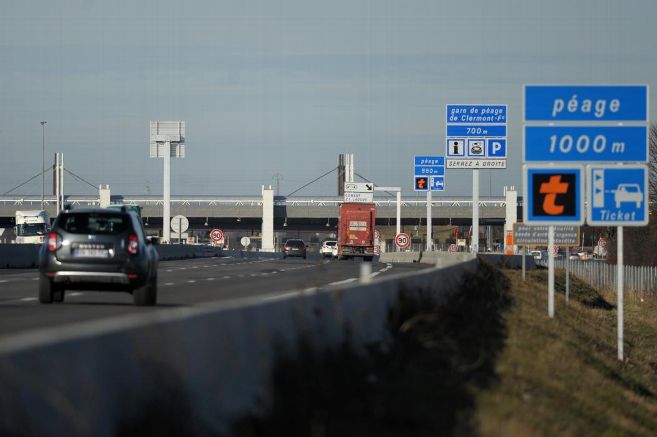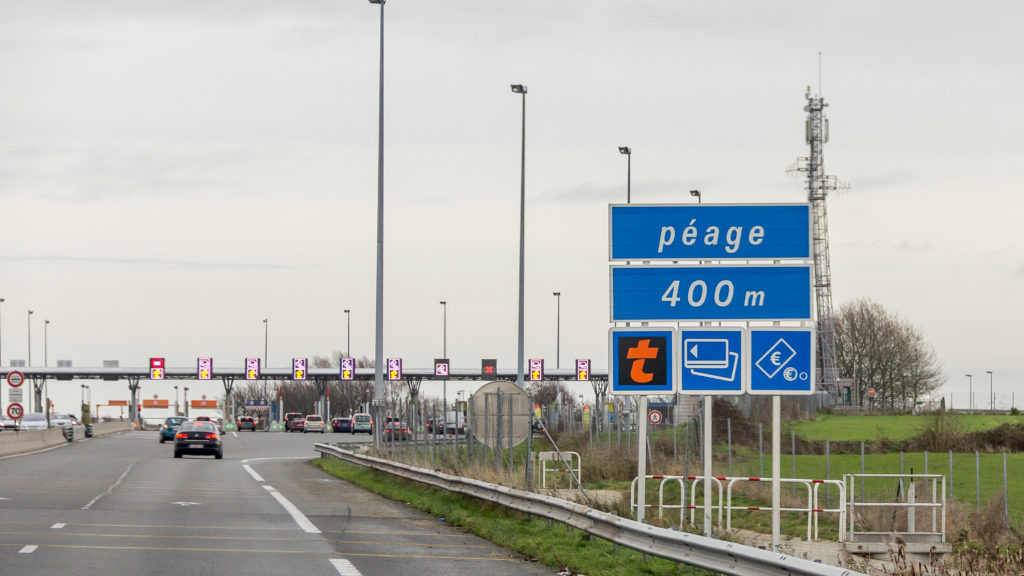
Unless drivers have telepeage, France’s version of EZ-Pass, drivers will want to get into a lane to get a ticket when they see this sign.
Autoroutes are one of the things that work well in France. (See “La Vie en France #28: What Works in France.”) However, they are absolutely terrifying to most first-time drivers–largely because of the toll booths. This post will extol the virtues of the French autoroutes; provide a few basic rules; and explain the toll system.
The Virtues of France’s Autoroute System
- There are virtually no potholes. The Webmaster believes that there are several reasons for this: First, construction starts with a higher quality road surface. Second, there is less traffic–at least in Loraine. Third, trucks are likely restricted to lighter loads. Fourth, France generally does not have the temperature extremes experienced in the U.S.
- There are also no tire retreads littering the autoroutes, because Europe does not allow trucking companies to use retread tires.
- To discourage distracted driving, the French authorities have built in rest areas (aires) approximately every 30 – 40 km. (18 – 25 miles.) The aires generally alternate between a full-service aire–complete with gas, restaurants, food shop and WC–and rest areas only–with a WC and picnic space.
- Most aires are open 24/7; but some services might be limited over night.
- The aires offer women a restroom; whereas it is often difficult to find one in the country where restaurants and cafés are scarce or often closed.
- The aires also offer gasoline–especially on Sunday when most of the country is closed. However, drivers will pay a much higher price for gasoline purchased at the aire as opposed to the local hypermarket such as Cora, Intermarche and Leclerc.
- Lane discipline is largely maintained–and enforced!
A Few Driving Rules
- Narrower roads, lane discipline enforcement, etc. result in European driving requiring much more active attention than driving on U.S. highways–especially in the country.
- Unless marked, the autoroute speed limit is 130kmh (78 mph) in good weather and 110kmh (66 mph) in rainy weather. Having said that, there are relatively few speed cameras in France compared to Germany, the U.K. and Belgium. Occasionally, the Gendarmes are enforcing speed limits.
- Trucks are generally limited to 90kmh (54 mph); so it seems that one is forever passing trucks.
- Lane discipline is enforced by the Gendarmes: Drivers should stay in the right lane unless they are passing another vehicle!
- If one is in the middle or left lane, and a faster car is approaching, one should move to the right lane as quickly and safely as possible.
- Distracted driving, such as eating, drinking or texting, can come with very large penalties! One might notice that cars built for Europe have significantly fewer cup holders than cars built for the U.S.
Peage (Tolls) De-mystified
- High tolls are the one downside to using autoroutes: It costs approximately 18 Euros–one way–to drive from CDG to the Meuse-Argonne.
- Rental cars are not equipped with telepeage, France’s equivalent to the U.S. EZ-Pass system. Therefore, one should avoid getting into a lane that is marked only with a “t.”
- Therefore, when one ENTERS a toll section one should look for a lane displaying the ticket sign shown in the photo above.
- When one EXITS a toll section there are three alternatives, as shown in the photo below: “t” for telepeage, card for credit cards and bills and coins for cash. One should choose one of the latter two options.
- As in the U.S., one can generally use telepeage in any lane. Therefore, ignore the “t” and focus on finding a lane displaying the card or bills and coins; depending on how one wishes to pay.
- In theory it is not difficult, but until one gets close to the toll booth the card and the bills and coins symbols look similar. The best thing to do is to remain calm and alert.
Bonne Route!


